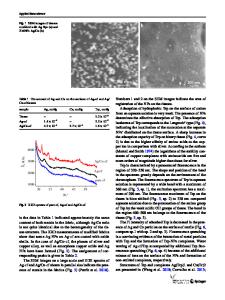Effect of Transition Metal Impurities on the Adsorption of Flotation Reagents on Pyrite Surface
- PDF / 1,102,264 Bytes
- 7 Pages / 595.276 x 790.866 pts Page_size
- 88 Downloads / 316 Views
Effect of Transition Metal Impurities on the Adsorption of Flotation Reagents on Pyrite Surface Yingchao Liu 1 & Yuqiong Li 2,3 & Jianhua Chen 2,3 & Mingfei He 4 Received: 29 May 2020 / Accepted: 17 September 2020 # Society for Mining, Metallurgy & Exploration Inc. 2020
Abstract Pyrite is one of the most common sulfide minerals on earth, which is usually grown with chalcopyrite and other sulfide minerals. In flotation practice, pyrite from different mines or different sections in a same mine may have different flotation behaviors. This is because the pyrite crystal contains lattice defect, including ionic vacancy and lattice impurity. The present work investigates the effects of three typical 3d transition metal (Co, Ni, and Fe) on the adsorption of CH3OCS2−, OH−, and CN− on pyrite surface by density functional theory (DFT) calculations. Calculated results show that Co impurity reduces the adsorption energies of CH3OCS2− and CN− on the surface of pyrite, while Ni and Cu impurities significantly increase the adsorption energies of CH3OCS2− and CN− on the surface of pyrite. Co impurity has small influence on the adsorption of OH−, but Ni and Cu impurities significantly increase the adsorption energies. Calculations on Mulliken charge population of Co2+, Ni2+, and Cu2+ indicate that the Mulliken charges of Co2+, Ni2+, and Cu2+ after OH− adsorption are more than those after CN− adsorption. This suggests that the ionic property of the M-OH- coordination bond is greater than that of M-CN- coordination bond, while covalent bonding of M-CN- coordination bond is greater than that of M-OH- coordination bond. The adsorption results are discussed based on coordination field theory (CFT). Keywords Pyrite . Transition metal impurities . Flotation reagent . Coordination field theory
1 Introduction Pyrite is a most common ore on earth, which is always coexisted to chalcopyrite, sphalerite, and coal mine. In the process of flotation separation, the flotation behaviors of pyrite from different mines or different sections in a same mine are different. Some researchers propose that the difference in mineralogy is the dominant cause for this phenomenon. The
* Jianhua Chen [email protected] * Mingfei He [email protected] 1
School of Chemical Engineering, Guangxi University, Nanning 530000, Guangxi, China
2
School of Resource, Environment and Materials, Guangxi University, Nanning 530000, Guangxi, China
3
Guangxi Key Laboratory of Processing for Non-ferrous Metal and Featured Materials, Guangxi University, Nanning 530000, Guangxi, China
4
Guangdong Institute of Resource Comprehensive Utilization, Guangzhou 510650, Guangdong, China
difference in mineralogy is caused by lattice defect, which includes ionic vacancy and lattice impurity. Lattice defect has a considerable impact on the crystal structure, electronic structure, and reactivity of pyrite. Huang and Li thought that the presence of Co and Ni impurity will decrease the covalent value of bonds on pyrite surface by density functional theory (DFT) calculations [1]. Ferrer et
Data Loading...









